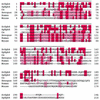Structure and function of the fourth subunit (Dpb4p) of DNA polymerase epsilon in Saccharomyces cerevisiae
- PMID: 11024162
- PMCID: PMC110797
- DOI: 10.1093/nar/28.20.3846
Structure and function of the fourth subunit (Dpb4p) of DNA polymerase epsilon in Saccharomyces cerevisiae
Abstract
DNA polymerase epsilon (Polepsilon) of Saccharomyces cerevisiae is purified as a complex of four polypeptides with molecular masses of >250, 80, 34 (and 31) and 29 kDa as determined by SDS-PAGE. The genes POL2, DPB2 and DPB3, encoding the catalytic Pol2p, the second (Dpb2p) and the third largest subunits (Dpb3p) of the complex, respectively, were previously cloned and characterised. This paper reports the partial amino acid sequence of the fourth subunit (Dpb4p) of Polepsilon. This protein sequence matches parts of the predicted amino acid sequence from the YDR121w open reading frame on S.cerevisiae chromosome IV. Thus, YDR121w was renamed DPB4. A deletion mutant of DPB4 (Deltadpb4) is not lethal, but chromosomal DNA replication is slightly disturbed in this mutant. A double mutant haploid strain carrying the Deltadpb4 deletion and either pol2-11 or dpb11-1 is lethal at all temperatures tested. Furthermore, the restrictive temperature of double mutants carrying Deltadpb4 and dpb2-1, rad53-1 or rad53-21 is lower than in the corresponding single mutants. These results strongly suggest that Dpb4p plays an important role in maintaining the complex structure of Polepsilon in S.cerevisiae, even if it is not essential for cell growth. Structural homologues of DPB4 are present in other eukaryotic genomes, suggesting that the complex structure of S. cerevisiae Polepsilon is conserved in eukaryotes.
Figures



Similar articles
-
Dpb11, which interacts with DNA polymerase II(epsilon) in Saccharomyces cerevisiae, has a dual role in S-phase progression and at a cell cycle checkpoint.Proc Natl Acad Sci U S A. 1995 Dec 5;92(25):11791-5. doi: 10.1073/pnas.92.25.11791. Proc Natl Acad Sci U S A. 1995. PMID: 8524850 Free PMC article.
-
Dpb2p, a noncatalytic subunit of DNA polymerase epsilon, contributes to the fidelity of DNA replication in Saccharomyces cerevisiae.Genetics. 2008 Feb;178(2):633-47. doi: 10.1534/genetics.107.082818. Epub 2008 Feb 1. Genetics. 2008. PMID: 18245343 Free PMC article.
-
Mismatch repair-independent increase in spontaneous mutagenesis in yeast lacking non-essential subunits of DNA polymerase ε.PLoS Genet. 2010 Nov 18;6(11):e1001209. doi: 10.1371/journal.pgen.1001209. PLoS Genet. 2010. PMID: 21124948 Free PMC article.
-
Diverse roles of Dpb2, the non-catalytic subunit of DNA polymerase ε.Curr Genet. 2017 Dec;63(6):983-987. doi: 10.1007/s00294-017-0706-7. Epub 2017 May 17. Curr Genet. 2017. PMID: 28516230 Free PMC article. Review.
-
DNA polymerase II, the epsilon polymerase of Saccharomyces cerevisiae.Prog Nucleic Acid Res Mol Biol. 1993;46:93-120. doi: 10.1016/s0079-6603(08)61019-3. Prog Nucleic Acid Res Mol Biol. 1993. PMID: 8234788 Review. No abstract available.
Cited by
-
Shrimp ATP synthase genes complement yeast null mutants for ATP hydrolysis but not synthesis activity.Mol Biol Rep. 2012 Oct;39(10):9791-9. doi: 10.1007/s11033-012-1845-z. Epub 2012 Jun 21. Mol Biol Rep. 2012. PMID: 22718514 Free PMC article.
-
Sensing of replication stress and Mec1 activation act through two independent pathways involving the 9-1-1 complex and DNA polymerase ε.PLoS Genet. 2011 Mar;7(3):e1002022. doi: 10.1371/journal.pgen.1002022. Epub 2011 Mar 17. PLoS Genet. 2011. PMID: 21436894 Free PMC article.
-
Polymerases ε and ∂ repair dysfunctional telomeres facilitated by salt.Nucleic Acids Res. 2016 May 5;44(8):3728-38. doi: 10.1093/nar/gkw071. Epub 2016 Feb 15. Nucleic Acids Res. 2016. PMID: 26883631 Free PMC article.
-
The Arabidopsis thaliana Nuclear Factor Y Transcription Factors.Front Plant Sci. 2017 Jan 10;7:2045. doi: 10.3389/fpls.2016.02045. eCollection 2016. Front Plant Sci. 2017. PMID: 28119722 Free PMC article. Review.
-
Regulation of the developmental programs in Toxoplasma by a novel SNF2L-containing chromatin remodeling complex.Nat Commun. 2025 Jul 1;16(1):5757. doi: 10.1038/s41467-025-60795-1. Nat Commun. 2025. PMID: 40593611 Free PMC article.
References
Publication types
MeSH terms
Substances
LinkOut - more resources
Full Text Sources
Molecular Biology Databases

